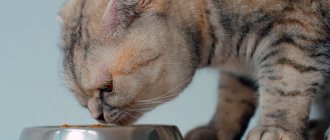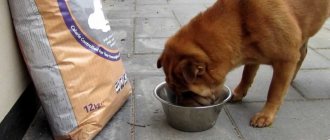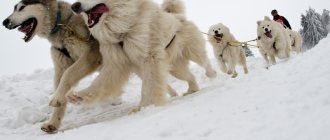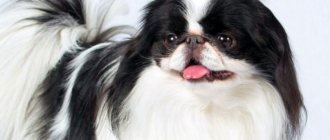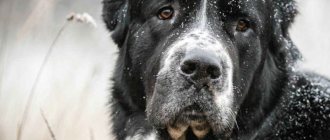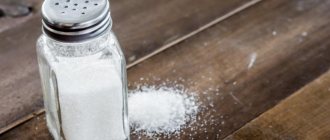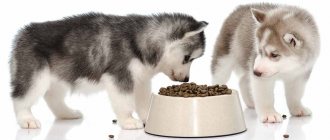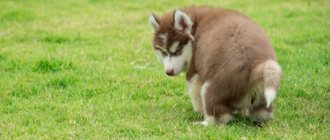In order for your pet to delight with a confident stance, shiny coat, even posture, activity and health, it is important to provide him with proper feeding. The menu should be filled with natural food; the recipe for preparing it is not simple, but your pet will thank you. What’s especially nice about natural feeding is that you can see the results of your efforts very quickly.
Note! Feeding your dog natural food will allow your pet to be more resistant to parasites, infections and poisons.
What is natural feeding?
Natural and natural food can be called food that does not contain dry food. In addition, this option for feeding a dog is balanced, nutritious and varied. With food, the dog will not swallow harmful additives, excess salt, flavorings and other nasty things that your pet does not need. They are included in the industrial feed recipe for long-term preservation.
Naturally, natural feeding of dogs is more to the liking of the animal, however, the owner will need to spend time preparing food and find a recipe that will suit the pet. The diet will have to be balanced on your own so that it contains vitamins and microelements.
Note! Feeding your dog using natural products will cost you more than using store-bought dry food.
Natural food is considered to be one that includes:
- Meat and offal.
- Medium-fat fermented milk products.
- Vegetables and selected unsweetened fruits.
- Bran from grain crops.
In order to balance your dog’s diet, it is advisable to mark the products and portions used. Such a table will help organize balanced feeding and slightly reduce the time spent searching for a suitable menu.
Should you feed your dog natural food?
What to feed Shar Peis at home: which food is better
Natural feeding for a dog is suitable when the owners are willing to regularly buy fresh food and spend time processing it. In addition, natural fiber has a number of advantages:
- the owner personally controls the cooking;
- such nutrition is as close as possible to the natural “wild” diet;
- The menu can be constantly changed and include different products.
This diet is good for dogs with allergies, such as Chihuahuas. Some breeds may experience negative reactions to food components, but with natural feeding it is much easier to eliminate the allergen.
Dry food and natural food: to interfere or not?
Every dog, regardless of its breed, needs balanced feeding; this will be easiest to achieve with a natural dog. You will definitely have to spend money on feeding, and if you have already decided to get an animal, you should not save. This can lead to health problems and the dog will suffer for the rest of his life.
You should not give dogs vinaigrette with dry food and natural food. The consequences may be:
- metabolic disease;
- negative impact on microflora;
- vitamins and microelements in industrial feeds can lead to hypovitaminosis.
Note! The daily rate of natural feeding is calculated based on the weight of the animal. Otherwise, the animal may be at risk of obesity or malnutrition.
Features of feeding dogs of different sizes
For the first month, the puppy is fed with mother's milk. Then you need to gradually add natural food.
Small breeds need food that is rich in protein and calcium. Such dogs are more susceptible to fractures, sprains and early tooth loss. The average number of feedings per day should be about 3 times. If your terrier or other breed is prone to obesity, you may need to reduce the portion size. It is better to divide food into 4-5 meals, but in small volumes. Large dogs need an increased amount of meat. This is especially true for hunting breeds, as well as those that are excessively active during the day.
Features of feeding regimen and portion size
The regime mainly depends on the age of the dog. Feed depending on age, but not regardless of food, as indicated in the table:
- Up to 1 month – 6-8 times.
- 2-3 months – 5-6 times.
- 6-12 months – 3 times.
- 1 year and older – 2 times, that is, adult mode.
Sometimes breeders feed adult pets 3 times - this should only be done if the pet is prescribed a special diet, in other cases there is no need to feed it so much natural food. Also, you should not feed the dog once, but with a large portion; the animal is unlikely to think of dividing the received products into several meals.
It is impossible to say specifically by the serving size, since it depends on the energy value of the products. In order for the animal to receive the necessary set of natural food, a table of the nutritional value of foods will help. It is very important to calculate the daily norm with an understanding of the energy value of each product, because on the basis of this the portion and number of calories will be calculated.
What foods should a dog's diet consist of?
Natural feeding of a dog (the correct menu is given below) should include a variety of foods. The basis of the daily diet is meat, followed by cereals, vegetables and fruits. All these components help maintain the balance of proteins, fats and carbohydrates in the body.
Dairy products
Why dogs can’t eat pork: can you feed it or not?
1/3 of the daily menu should be based on fermented milk products. For the German Shepherd and other breeds, the most suitable options are: fermented baked milk, sour cream, cottage cheese and kefir.
Note! Products are selected with a small percentage of fat content.
If your pet experiences diarrhea when consuming fermented milk products, this food should be excluded from the diet. You should not give milk to dogs. This product is poorly digestible and negatively affects the gastrointestinal tract.
Meat day
The menu for a dog every day (natural) must include meat. This applies to all breeds, from small dachshunds to large huskies. Depending on the weight of the pet, the meat product should take up from 60 to 80% of the daily diet. Beef from which the fat has been removed is ideal for all animals. You can also use lamb, horse meat and rabbit. Experts recommend avoiding pork, as it puts a lot of stress on the liver, and in its raw form it often acts as a carrier of parasites.
Chicken, turkey and offal are added gradually, observing the animal's reaction. If there is no allergy, then the product can be included in your regular diet.
Vegetables, greens, grains
The diet for a natural dog should include the following types of cereals:
- rice;
- buckwheat;
- barley;
- oatmeal.
This is an inexpensive option to dilute regular meat and prepare a side dish. You can cook porridge in meat broth using beef bones. Vegetables are grated or cut into small cubes. These products are served every day. Once a week, add a clove of garlic and 1 spoon of sauerkraut to your food. In addition, carrots, cucumbers, pumpkin, peppers and beets are used. The amount of greens consumed must be monitored, especially in the summer. Otherwise, it may lead to diarrhea or flatulence.
Note! Citrus fruits cannot be used. They adversely affect the gastrointestinal tract and cause allergic reactions.
Sea fish
The norm for fish is once a week. Even if the dog loves fish very much, you cannot put him on such a diet. Lack of meat in the diet will lead to a lack of thiamine and an excess of vitamin B1. When choosing a seafood product, you should pay attention to the following rules:
- Low-fat types are best;
- the fish must be well frozen to remove the risk of infection with parasites;
- You can serve boiled or fresh;
- You should not give raw lake and river fish.
Yorkshire Terrier Barbara is prone to overeating, so it is important to control portions
Eggs
Eggs are a food source of protein and amino acids. If the owners are confident in the quality of the products, then they can be given raw several times a week.
Menu for natural dog feeding
The menu for feeding a dog with natural food is compiled in accordance with the animal’s needs, and too much variety is not observed here. It’s worth introducing innovations, even when feeding natural food, no more than a couple of times a week.
Meat
A dog, even a domestic one, is still a carnivore, and the basis of the menu should be meat. For starters, this excellent source of protein will be a natural and therefore easily digestible food for the animal. The daily content of meat products should be 70-80%. Optimal nutrition: beef, poultry (turkey and chicken), horse meat, veal. It is recommended to give offal - offal, liver, spleen, tripe. But they should not be included in the diet more than 2-3 times a week. They have a lower energy value than meat, so their quantity per serving should be greater.
The recipe for cooking meat is simple. It is best to give it raw, cut into pieces that are easy for dogs to eat.
Another option for protecting your pet from parasites that may be in the meat is to freeze it before feeding it. Such meat can become normal food only after it has been completely defrosted and reached room temperature.
Note! Before feeding, the meat must be soaked in boiling water.
In some cases, you can feed boiled meat or minced meat, but reduce their quantity. An excellent source of easily digestible protein is fresh blood. It contains many essential amino acids. It must be given fresh; it is considered fresh within a few hours after the animal is slaughtered. After 6-10 hours it needs to be cooked. Blood can be given 2 times a month.
Bones
This natural food is a must-have for dogs. But there are some nuances in feeding such products, including:
• It is forbidden to use tubular, rib and other bones in feeding dogs, which can break into fragments under pressure from teeth. This is dangerous for the animal's life. • During natural feeding, bones should be fed raw. • You can give porous bones - brisket, shoulder blade.
Fish
Fish is indicated from 4-5 months, and only in boiled form. Fatty varieties are best; they need to be pitted before cooking. Feeding such foods is an additional source of protein in the animal’s food.
There are restrictions on filling the diet with natural food of this type:
- Fish with bones.
- Raw fish of any kind.
- Smoked meats.
- River fish, it may contain dangerous helminths.
It is useful to include in the menu for dogs: perch, bream, halibut, trout, sea bass, pollock, pike perch.
This natural food should be enjoyed by your pet 1-2 times a week. You should not mix fish in one portion with meat; it is better to give them separately.
Note! When feeding your dog fish, you need to take reasonable precautions, because fish has the ability to break down B vitamins, which will negatively affect health.
Proper feeding of fish can be made cheaper by offering your pet bulls, well-boiled ones; you don’t even have to take out the bones.
Dairy
The diet should include dairy products. This will become a natural and familiar food for the stomach. Whole milk should be given to puppies. As you grow older, switch your dog to fermented milk products - cottage cheese, yogurt, fermented baked milk, yogurt. As a dog ages, the number of enzymes responsible for processing milk proteins decreases, so you should not give too much milk.
Natural diet
When studying the list of foods allowed for a dog to eat, the owner should be well versed in the most preferred types of food. Each of them affects the pet’s body in its own way, so even meat or good offal under certain conditions can cause harm to the dog’s body. The same applies to other components of a dog’s regular natural menu.
Meat, fish and offal
The best option for the meat component of a dog’s diet is beef, as well as beef by-products (for example, kidneys or lungs), which are also rich in protein, important vitamins, macro- and microelements, in the absence of ash and a large amount of animal fats. Tendons and ligaments can act as treats for human four-legged friends, although you can also purchase specially treated ears and cartilage from pet stores. An alternative to beef is often chicken, which has long been considered a good dietary product. Many dogs eat chicken fillet and offal very well, but in some cases such food leads to the development of allergies. This is due to the use of growth stimulants when raising poultry in factories, which are deposited in significant quantities in the bones of chickens, but can also accumulate in their meat.
Instead of chicken, it is beneficial to feed dogs turkey meat. It is more nutritious, contains saturated fatty acids and a large supply of vitamins, so it is considered a good addition to a pet’s diet. Rabbit meat is no less popular when feeding pets, of course, if the dog breeder has the opportunity to periodically buy such a dietary product. It is easily absorbed by the dog’s body, saturates it with a large amount of B vitamins, as well as proteins and fats.
As for the popular pork, it is significantly inferior to previous varieties of meat, which is largely explained by its high level of fat content and the presence of proteins that are unsuitable for the dog’s body. If you frequently feed your dog pork meat or offal, the animal may experience indigestion, especially if it has previously had problems with the gastrointestinal tract. As an exception, it is allowed to give your pet lean pork tenderloin, heart, kidneys and other offal, but they are still not suitable for constant feeding.
Did you know? Subject to normal development, “non-biting” dog breeds include the Alaskan Malamute, Husky, Samoyed and Newfoundland, despite its large size.
Dairy and fermented milk products
Milk in its pure form is appropriate only when feeding small babies, and then after partial dilution with water, especially if it has a high fat content. With age, the pet's digestive system loses the ability to break down lactose normally, resulting in constipation and impaired digestibility of not only milk, but also other products based on it.
To prevent unwanted consequences, dogs include only a few products on their menu:
- Cottage cheese is a valuable source of B vitamins, calcium, phosphorus, selenium and potassium. Low-calorie versions of this product can be given to dogs approximately 2-3 times a week, using 1-6 tbsp. spoons at a time (taking into account age). It is often introduced into the diet of even dogs weakened by disease, but only if there are no problems with their digestive system: in rare situations, a low-fat product causes constipation, inflammation of the pancreas and other problems associated with the effect of fat on the dog’s body. In addition, low fat content often causes disturbances in the body’s absorption of calcium, which is so necessary for the active growth of the puppy.
- Yogurt. As in the previous case, it is advisable to give preference to low-calorie versions of this product when introducing it into the menu of dogs older than three months. The best option is dairy products without sugar, fruits and berries, chocolate and other flavoring additives, dyes and natural fat substitutes. For adult pets of large breeds, 100 ml of yogurt per day is enough, and for small animals, 1 teaspoon is enough. A high-quality dairy product helps strengthen the pet’s skeletal system, and also normalizes the functioning of the nervous system and ensures better absorption of vitamins C and E present in yogurt.
- Kefir - enriches the dog’s body with calcium, iodine, magnesium, phosphorus, fatty acids, vitamins A and D. Unlike previous dairy products, it contains a considerable amount of probiotics that are beneficial for the animal, helping to improve digestive processes. Due to its ease of absorption and minimal fat content, this product is perfect for animals suffering from pancreatitis. Pets of small breeds are usually given no more than 1 teaspoon of kefir at a time, and their larger relatives - 5-6 tablespoons, about 2-3 times a week.
- Cream (fat content no more than 10%). Allowed for use only when feeding puppies that have recently been weaned from their mother. This product is used to dilute porridge, or give it to children to lick in its pure form.
- Dairy waste. Sometimes buttermilk and whey are included in the diet of domestic dogs, with the lowest possible amount of fat in the composition. Moreover, both products are rich in protein, calcium, potassium, magnesium, phosphorus and vitamins, which are important for dogs with diseases of the gastrointestinal tract, kidneys and liver. They use the whey to prepare porridges or pour it into a bowl in its original form, because they like it much more than buttermilk.
- It is advisable to include hard varieties of cheese in your pet’s menu only as a treat and as a reward for good behavior during training. This product is not suitable for daily nutrition due to its high fat content. For adult animals of small breeds, 30 g of cheese per day is enough, and for representatives of large breeds - no more than 70 g. Processed cheese, which carries virtually no nutritional value, is considered a prohibited type of cheese for dogs.
Important! When introducing any new product into your pet’s diet, you should start with a small amount, carefully monitoring changes in the dog’s behavior. If the animal refuses the offered food and has problems with stool, any dairy products should be excluded from the animal’s menu.
Porridge
It is almost impossible to imagine a dog’s natural diet without the presence of cereals in it. Many cereals have a positive effect on digestive processes and enrich the animal’s body with useful minerals and vitamins: E, PP, group B. Rice and buckwheat are deservedly considered the most valuable in this regard, but often porridges are cooked for pets based on barley, oatmeal, wheat or mixtures of them.
After cooking, rice and oatmeal release natural mucus that coats the dog's stomach and protects it from irritation. Typically, such cereals are recommended for feeding animals suffering from gastritis and ulcers. Buckwheat saturates the body with protein and carbohydrates, barley and wheat cereals are included in the diet a little less often, but it is advisable not to cook barley, millet and legumes at all for dogs. These crops are not so well absorbed by the animal’s digestive system, not to mention the possible harm: they can cause excessive gas formation and colic in the stomach.
Regardless of the type of cereal chosen, it must be boiled until it is “uniformly soft,” but not completely disintegrated. Knead the lumps that appear with a spoon after adding a small amount of butter, but not more than 1-2 times a week. The volume of such an additive is based on the amount of porridge, but in most cases it should not be 0.1–0.5%. To reduce the amount of harmful animal fats in a dog’s diet, butter is replaced with vegetable oil, usually choosing olive or flaxseed. Their volume is increased to 1% of the total volume of porridge.
Sometimes, before giving it to the dog, fish oil is added to the dish: it can be either in liquid form or in capsule form. Spices are taboo for pets, just like baked goods, which are often thrown into the pan when cooking cereals to make them more filling.
Fruits and vegetables
Vegetables are a good source of vitamins A, E, PP, D, group B, not to mention fiber, which is important for the stomach (helps remove waste and toxins from the body, improves intestinal motility, thereby facilitating better passage of food through the digestive tract). Carrots, zucchini, beets, pumpkin and seeded sweet peppers are especially beneficial for dogs. In addition, some animals willingly eat cucumbers, broccoli and even cabbage, although the latter is best given in limited quantities. Among fruits, many dogs prefer apples, bananas, blueberries, pears and watermelon; the main thing is to choose sweet varieties. All fruits are fed to pets only raw, after being peeled and cut into slices.
The list of vegetables and fruits prohibited for dogs includes mushrooms, avocados, strawberries, garlic, onions, grapes, both fresh and dried. In addition, you should not give her dill, parsley and lettuce.
We recommend reading how to switch a dog from natural food to dry food.
Sweets and baked goods
Most dogs will never give up sweet cookies, buns or even regular bread, but all these products are unlikely to benefit their body. Thus, flour products may well become the root cause of colic, increased gas formation and associated bloating, not to mention more serious cases of volvulus. In addition, baking has a negative effect on metabolic processes, not to mention the pet’s tendency to obesity.
Marmalade, sweets and especially chocolate are strictly contraindicated for dogs, as they often become the main cause of allergies, circulatory and metabolic disorders. To treat your pet, you can prepare the treat yourself without using sugar, caffeine or cocoa. Rye crackers and biscuits are perfect for these purposes, but you shouldn’t overuse them.
Useful recipe:
- Add 1 tbsp to 1 liter of milk. l. calcium chloride. It can be bought at a pharmacy.
- Bring the mixture to a boil, stirring, and leave on the stove until it cools.
- During this time, the whey and dense curd mass will separate.
- You can strain it or give it as is.
From time to time, this calcined cottage cheese should be fed to the animal - this will become a natural prevention of problems with bone tissue. Vitamins for natural fed dogs
Feeding a dog natural food gives the pet all the necessary vitamins, if the diet is balanced.
It is allowed to give grains to dogs when feeding them naturally. They should be cooked in vegetable or meat broth. Moreover, the bones will be an excellent basis for meat broth, since meat loses most of its nutrients during the cooking process. There is no need to give the bones to the dog after boiling. The meat can be added to the porridge a few minutes before the end of cooking. It is better to add the bulk of the meat portion to the porridge in its raw form; eating such natural food will be tasty and healthy.
Cereals should be varied, but most dogs like rice and buckwheat the most. Vegetables are also needed, all boiled.
Making up your diet correctly: important tips and recommendations
What to feed a Jack Russell Terrier: at home
When creating a natural food menu for a dog for a week, you must adhere to the following rules:
- each product is prepared separately and mixed in a bowl immediately before serving to the pet;
- the portion should be calculated for one time so that leftover food does not remain in the bowl and spoil;
- the dog should always have access to clean water;
- In addition to the diet, it is necessary to add vitamin complexes;
- meat and dairy products are given in different doses;
- meat and offal are given raw, after freezing them in the freezer for several days;
- vegetables are grated or chopped into small pieces;
- porridge should be cooked in water or broth;
- a dish for dogs does not need salt and pepper;
- Do not mix natural and dry food.
Bulldog Schaefer needs 250 g of meat per day
How to fatten a dog?
Meat becomes the main component of the menu for skinny animals. It is a source of essential amino acids that are not found in plant foods and fish. If a dog has not eaten meat for a long time, it is given boiled meat and only lean meat. The daily menu consists of 75-80% meat.
The rest of the diet is plant foods. For example, cereals. Dogs can be given buckwheat, oats, rice. Corn can cause allergies. Wheat is not suitable for feeding carnivores. When cooking cereals, no salt is added. Meat cut into pieces, as well as vegetables, fruits, and herbs are added to the porridge.
If a dog has suffered enteritis, its food should be pureed and semi-liquid: boiled pieces of meat, fermented milk products, liquid oatmeal, vegetable soup.
The female's nutrition after weaning the puppies is supposed to be enhanced, according to a certain feeding scheme for pregnant and lactating dogs.
Nutritional supplements
How and what else to feed an emaciated dog to help it gain weight? Among the useful additives:
- Meat and bone meal is a powder obtained from processed animal carcasses. In some countries it is used as fertilizer. In dog nutrition it is considered a source of calcium, phosphorus, and protein. Large pets are given up to 2 teaspoons of flour per day, adding to food before serving.
- Fish oil is a useful supplement that strengthens the animal’s immune system and skeletal system. The product helps prevent many diseases. Give fish oil to the dog 2-3 times a week, mixing a small amount of it into food in the dosage prescribed on the product’s packaging.
- Seaweed is a source of iodine and other beneficial microelements. Large dogs can be given up to 100-150 grams per day.
- Plantain - normalizes the functioning of the gastrointestinal system, improves the blood formula, and raises hemoglobin levels. You can add a little of the leaves of this herb to your dog's food.
- Eleutherococcus leaves - increase the dog’s performance, normalize heart function, are used as a growth stimulant, and improve coat quality. It is used in the form of a pharmaceutical tincture, which is given to dogs half an hour before meals. For small animals, 7 drops are enough, for large animals - 30.
Which dogs need to be fattened?
Female dogs can become emaciated after nursing a large litter of more than a dozen puppies. Also, emaciated animals after a serious illness or surgery need special nutrition.
Street dogs or pets that are lost and have been without a home for a long time can become exhausted. If stray animals are accustomed to feeding on leftover food from garbage dumps, then lost pets may refuse such food and lose a lot of weight.
Another cause of exhaustion is infection with parasites. Therefore, before you start fattening your dog, you should contact a veterinarian and rid the animal of worms.
Wasting is also possible in dogs that have to work hard but don't have enough calories to eat. This is especially possible for four-legged animals that transport cargo over long distances.
Sometimes it is necessary for the dog to gain weight before participating in the exhibition. It happens that it is necessary to show some characteristics of the breed, so dogs are forced to gain weight or lose weight.
An animal in old age may refuse food due to poor health. They are more susceptible to exhaustion than other pets due to metabolic disorders. How to fatten a dog in this case? You will definitely need the help of a veterinarian who will help you adjust the animal’s diet.
What can you feed a chihuahua and toy terrier?
Let's talk about such an important topic as the diet of your small dog. First of all, I would like to note that you can start feeding your dog from three weeks of age. The first foods introduced into a dog’s diet are porridge and cottage cheese. From 1 month, meat is gradually introduced into the dog’s diet.
When choosing a diet for a Chihuahua and Russian Toy Terrier, you should remember that the dog, no matter how large or small it is, is a wolf, so the basis of your pet’s diet should be protein food in an amount of at least 2/3 of the total diet . Protein foods include meat, offal, fish, poultry, cottage cheese, kefir, milk, eggs. Some veterinarians and experienced dog breeders recommend giving all these products exclusively raw. However, there is an alternative opinion on this matter. Opponents of raw food eating claim that raw foods (meat, fish, poultry, offal) may contain helminths or their larvae, which causes significant harm to the animal’s body.
Let's take a closer look at the foods that should be in the diet of your Toy or Chihuahua.
- Meat. The meat is given either in the form of pieces or planed. It is not advisable to give minced meat to a small dog: it is poorly digestible. For a small dog, the pieces of meat should be finely chopped. Eating fatty meat is unacceptable. Meat broth can be one of the options for diversifying your pet's diet. At the same time, it is not recommended to cook broth with bones: very frequent use of such broths leads to digestive problems in Chihuahuas and toy terriers. The ideal option is a broth based on cartilage, which contains a lot of collagen, which has a beneficial effect on the growth of bones and ligaments of a small dog. How much meat should a Chihuahua and Toy Terrier have in their diet? From ¼ to ½ of the weight of the entire diet. It should be borne in mind that a young growing body needs more meat than an old and sedentary dog.
- Offal. The liver and heart are the most useful by-products. The liver contains a large amount of vitamins A and D. The offal is thoroughly boiled and given no more than 1-2 times a week, but in a volume 1.5 times greater than the volume of meat.
- Fish. Small dogs, like the Chihuahua or Russian Toy Terrier, are given only sea fish - cod, hake, pollock. Containing a small amount of fat, they include the necessary amount of healthy fatty acids, as well as iodine and phosphorus necessary for the body. Fish should be offered no more than 1-2 times a week.
- Dairy products. Should be presented in the dog’s diet in the form of kefir and cottage cheese. It is not recommended to offer milk to small dogs older than 2 months: upon reaching this age, milk begins to be poorly absorbed by the body and does more harm than good. As for eggs, they are introduced into the diet raw and no more than 1-2 times a week.
- Cereals. Contain fiber necessary for intestinal function. Rice, rolled oats, and buckwheat are preferred in the diet. But millet and pearl barley are poorly absorbed by the body of a chihuahua and toy terrier, so it is better to avoid their use. Cereals should make up 1/3 of a small dog's diet.
- Vegetables and fruits. Compared to other products, they are less absorbed. As for vegetables, a small dog can consume carrots, which are an essential source of vitamin A. Carrots are given raw, thoroughly grated. It is best offered in combination with vegetable oil, since the vitamins contained in vegetables and fruits are best absorbed on an oil basis. You can also offer your Chihuahua and Toy Terrier cabbage, but not the stalk, because they contain the main nitrates that may have been added to the cabbage. But it is better not to introduce potatoes into your dog’s diet. In addition to the danger of poisoning with solanine contained in some tubers, potatoes interfere with the absorption of B vitamins. Cauliflower, zucchini, and tomatoes can also be introduced into the diet of a small dog. It is permissible to eat an apple as a fruit. Vegetables and fruits can make up ¼ -1/3 of the diet.
Here are the main foods that should be included in your small dog's diet.
